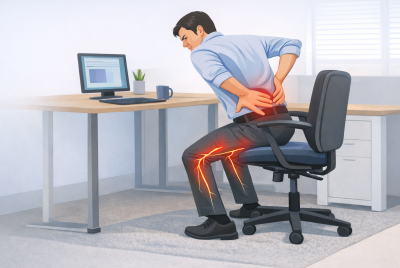Cycling with Sciatica
Discover how to cycle with sciatica in my personal guide to pain-free pedaling. Dive in now! Living with sciatica can be a daunting journey, but the good news is that it doesn’t have to be a roadblock to staying active. As someone who has navigated the world of sciatica, I’ve discovered that cycling can be a transformative ally in managing sciatic pain. In this comprehensive guide, I’ll delve deeper into the intricacies of cycling with sciatica, providing not only insights and tips but also a personal narrative to inspire your journey toward pain-free pedaling.
Understanding Sciatica
Before we dive into the world of cycling, let’s briefly understand what sciatica is. Sciatica is not a condition in itself but a symptom of an underlying problem, often involving the compression of the sciatic nerve, causing pain, tingling, or numbness that radiates from the lower back down the leg. Now that we’ve set the stage let’s explore how cycling can become a valuable component of your sciatica management plan.
Importance of Physical Activity
While sciatica may present challenges, embracing physical activity remains crucial. Cycling, being a low-impact exercise, emerges as a champion for those with sciatic pain. Beyond its physical benefits, cycling can positively impact mental health, promoting a holistic approach to well-being.
Cycling Pain-Free with These Tips
Choosing the Right Bike
Selecting the right bike goes beyond aesthetics; it’s about finding a companion that aligns with your body’s needs. Explore bicycles with ergonomic designs, paying attention to features such as shock absorption and a supportive saddle. These nuances can make a significant difference in minimizing pressure on the lower back and the sciatic nerve.
Proper Bike Setup
The devil is in the details when it comes to a pain-free cycling experience. A proper bike setup involves adjusting the saddle height, handlebar position, and overall alignment to conform to your body’s natural posture. These subtle tweaks can translate into miles of comfort and joy on your cycling journey.
Easy and Expert Bicycle Setup Tips
Warm-up and Stretching
Before you embark on your cycling adventure, give your body the warm-up it deserves. Incorporate dynamic stretches targeting the lower back, hips, and hamstrings to prepare your muscles for the ride ahead. This proactive approach can significantly reduce the risk of aggravating sciatic symptoms during your cycling sessions.
Riding Techniques
Cycling is not just about pedaling; it’s an art that, when mastered, can contribute to a pain-free experience. Adopting the right riding techniques involves maintaining an upright posture, engaging your core, and distributing your weight evenly on the pedals. These seemingly small adjustments can make a world of difference in your comfort and overall enjoyment.
Common Mistakes to Avoid
To truly embrace the benefits of cycling with sciatica, it’s crucial to be aware of common pitfalls. Avoid sudden movements, overexertion, and overlooking proper bike setup. Listening to your body is not just a suggestion – it’s a rule. If something feels off, take a moment to reassess and, if necessary, make adjustments.
Sciatica-Friendly Routes
Choosing the right terrain can be as important as choosing the right bike. Opt for smooth, flat surfaces that minimize jolts and shocks to your spine. Scenic cycling paths in parks or along rivers not only offer a picturesque backdrop but also contribute to a comfortable and enjoyable ride.
Listening to Your Body
In the realm of cycling with sciatica, your body becomes your best communicator. Pay attention to its signals and respond accordingly. If pain or discomfort arises, don’t push through it – take a break, assess the situation, and consider seeking professional advice if needed.
Post-Ride Recovery
Your journey doesn’t end when you dismount your bike; it continues with effective post-ride recovery techniques. From gentle stretches targeting specific muscle groups to applying ice or heat, these practices can expedite recovery, reduce muscle soreness, and contribute to a quicker return to the saddle.
Expert Advice
Don’t hesitate to seek guidance from healthcare professionals in the quest for pain-free cycling. A physiotherapist or orthopedic specialist can offer personalized insights and recommendations based on your unique condition. Their expertise can be invaluable in ensuring your cycling journey aligns seamlessly with your sciatica management plan.
Testimonials
Real-life success stories add a touch of inspiration to this journey. Countless individuals have found relief and joy through cycling despite their sciatica. These stories not only serve as motivation but also highlight the resilience of the human spirit in overcoming challenges.
Sciatica-Friendly Accessories
Enhance your cycling experience with supportive gear designed with sciatica in mind. Padded shorts, lumbar support belts, and ergonomic accessories can provide that extra layer of comfort, turning your ride into a soothing and enjoyable experience.
Mental Benefits of Cycling
The benefits of cycling extend beyond the physical realm. The endorphin release and the sense of accomplishment that accompany each ride contribute to stress relief, improved mood, and a positive outlook on life. Cycling becomes not just an exercise but a holistic therapy for the mind and body.
Frequently Asked Questions (FAQs)
Can cycling worsen sciatic pain?
Cycling has the potential to worsen sciatica pain if a poor bike setup or improper riding techniques are employed. Choosing the right bike, maintaining proper form, and being attuned to your body’s signals are essential. Active engagement in proper cycling practices is key to preventing the exacerbation of sciatic pain during rides.
How often should I cycle if I have sciatica?
The frequency of cycling with sciatica varies individually. Begin with shorter rides and gradually increase duration based on comfort levels. Actively listen to your body’s responses and avoid overexertion. Tailoring your cycling routine to personal tolerance is crucial, ensuring a balanced approach that aligns with your comfort and overall well-being.
Are there specific stretches for sciatica relief before cycling?
Yes, incorporate specific stretches targeting the lower back, hips, and hamstrings before cycling for sciatica relief. Actively engaging in these dynamic stretches can help alleviate tension, increase flexibility, and reduce the risk of sciatic pain during your ride. Prioritizing these pre-cycling stretches contributes to a more comfortable and pain-free cycling experience.
Can cycling cause long-term damage to the sciatic nerve?
Cycling, when executed correctly, is unlikely to cause long-term damage to the sciatic nerve. Employing proper techniques and bike setup actively minimizes risks. However, consulting with healthcare professionals is imperative for an individualized assessment, ensuring that cycling aligns with your unique condition and doesn’t pose a threat to the long-term health of the sciatic nerve.
Is stationary biking a better option for sciatica sufferers?
Stationary biking emerges as a superior option for sciatica sufferers. This active alternative provides control over terrain and intensity, minimizing external factors that could exacerbate pain during outdoor rides. Choosing stationary biking actively offers a controlled, low-impact environment, making it an ideal option for individuals with sciatica, promoting exercise without undue stress on the sciatic nerve.
Cycling with Sciatica – Conclusion
Embarking on a cycling journey with sciatica is not merely an exercise routine; it’s a lifestyle choice. By making informed decisions about your bike, setup, and riding techniques, you can transform cycling into a sciatica-friendly adventure. Remember to listen to your body, seek professional guidance when necessary, and savor the mental and physical rewards that come with pedaling through life with sciatica.
Disclaimer
Please note that the information provided in this article is for informational purposes only and should not replace professional medical advice. If you’re experiencing sciatica pain or any health concerns, it’s advisable to consult a healthcare professional for proper diagnosis and treatment.






